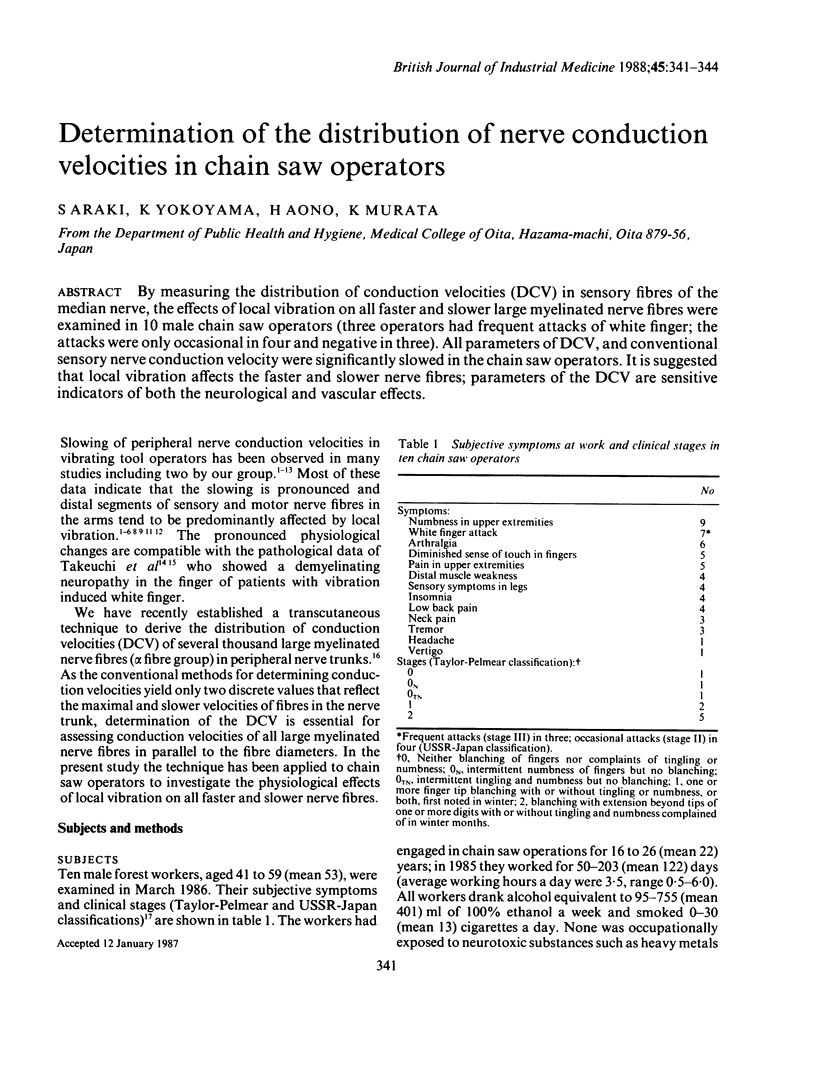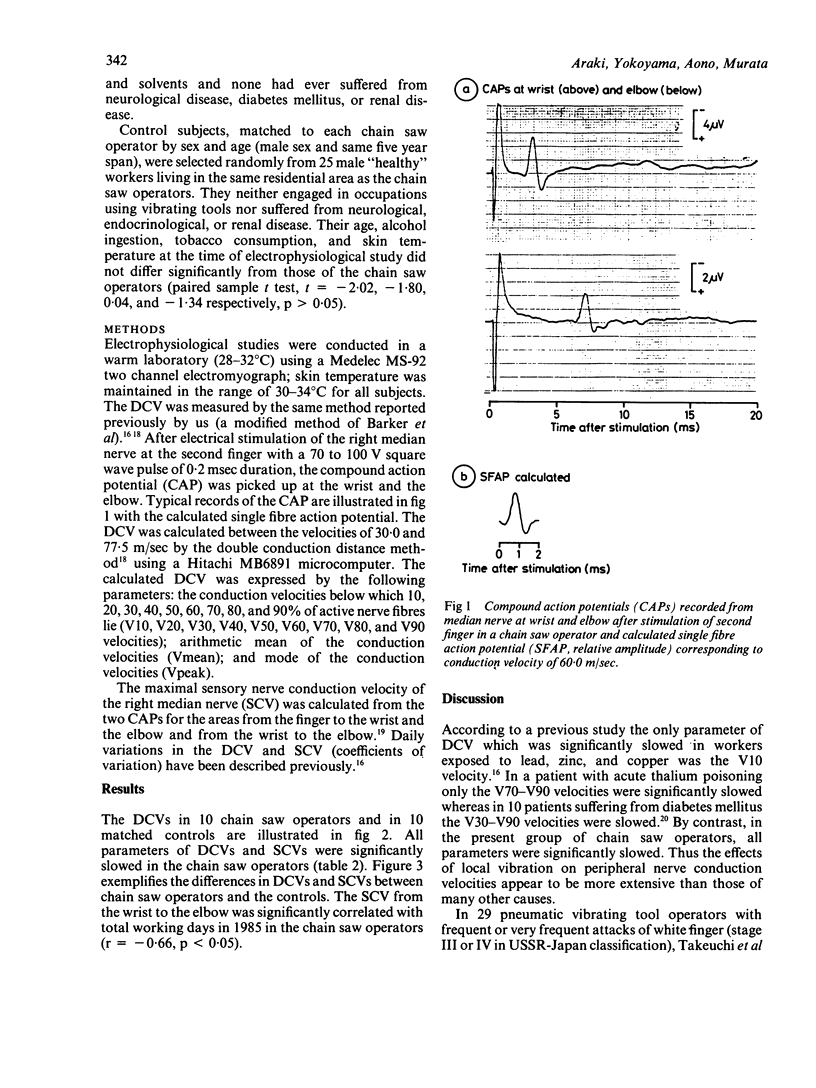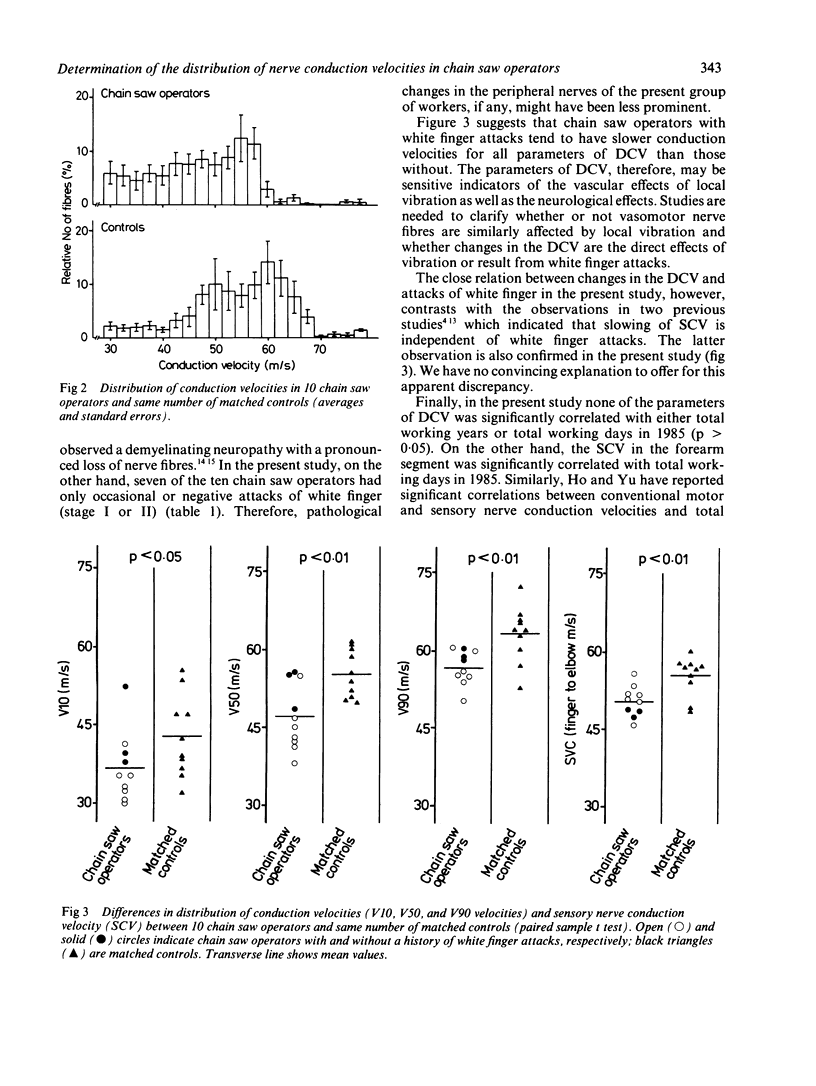Abstract
By measuring the distribution of conduction velocities (DCV) in sensory fibres of the median nerve, the effects of local vibration on all faster and slower large myelinated nerve fibres were examined in 10 male chain saw operators (three operators had frequent attacks of white finger; the attacks were only occasional in four and negative in three). All parameters of DCV, and conventional sensory nerve conduction velocity were significantly slowed in the chain saw operators. It is suggested that local vibration affects the faster and slower nerve fibres; parameters of the DCV are sensitive indicators of both the neurological and vascular effects.
Full text
PDF



Selected References
These references are in PubMed. This may not be the complete list of references from this article.
- Araki S., Honma T. Relationships between lead absorption and peripheral nerve conduction velocities in lead workers. Scand J Work Environ Health. 1976 Dec;2(4):225–231. doi: 10.5271/sjweh.2800. [DOI] [PubMed] [Google Scholar]
- Araki S., Yokoyama K., Murata K., Aono H. Determination of the distribution of conduction velocities in workers exposed to lead, zinc, and copper. Br J Ind Med. 1986 May;43(5):321–326. doi: 10.1136/oem.43.5.321. [DOI] [PMC free article] [PubMed] [Google Scholar]
- Barker A. T., Brown B. H., Freeston I. L. Determination of the distribution of conduction velocities in human nerve trunks. IEEE Trans Biomed Eng. 1979 Feb;26(2):76–81. doi: 10.1109/tbme.1979.326512. [DOI] [PubMed] [Google Scholar]
- Chatterjee D. S., Barwick D. D., Petrie A. Exploratory electromyography in the study of vibration-induced white finger in rock drillers. Br J Ind Med. 1982 Feb;39(1):89–97. doi: 10.1136/oem.39.1.89. [DOI] [PMC free article] [PubMed] [Google Scholar]
- Dylewska D. Badanie przewodnictwa nerwów ruchowych i czuciowych kończyn górnych w chorobie wibracyjnej. Neurol Neurochir Pol. 1970 Jan-Feb;4(1):27–31. [PubMed] [Google Scholar]
- Hisanaga H. [Studies of peripheral nerve conduction velocities in vibrating tool operators]. Sangyo Igaku. 1982 May;24(3):284–293. doi: 10.1539/joh1959.24.284. [DOI] [PubMed] [Google Scholar]
- Ho S. T., Yu H. S. A study of neurophysiological measurements and various function tests on workers occupationally exposed to vibration. Int Arch Occup Environ Health. 1986;58(4):259–268. doi: 10.1007/BF00377883. [DOI] [PubMed] [Google Scholar]
- Juntunen J., Matikainen E., Seppäläinen A. M., Laine A. Peripheral neuropathy and vibration syndrome. A clinical and neurophysiological study of 103 patients. Int Arch Occup Environ Health. 1983;52(1):17–24. doi: 10.1007/BF00380603. [DOI] [PubMed] [Google Scholar]
- Murata K., Araki S., Aono H. Assessment of central and peripheral nerve functions in chain-saw operators: a study of short-latency somatosensory evoked potential and peripheral nerve conduction. Tohoku J Exp Med. 1987 Jan;151(1):25–31. doi: 10.1620/tjem.151.25. [DOI] [PubMed] [Google Scholar]
- Takeuchi T., Futatsuka M., Imanishi H., Yamada S. Pathological changes observed in the finger biopsy of patients with vibration-induced white finger. Scand J Work Environ Health. 1986 Aug;12(4 Spec No):280–283. doi: 10.5271/sjweh.2140. [DOI] [PubMed] [Google Scholar]


